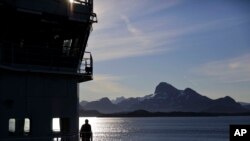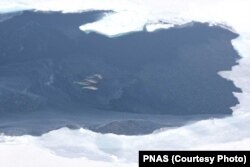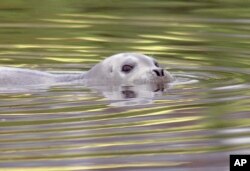The polar bear may be the animal most often identified with climate change, but it is far from the only creature at risk from rising temperatures.
The northernmost part of Earth is warming two to three times faster than the rest of the planet. This means the melting sea ice is opening new routes for shipping.
The melting ice has cleared space through the historically dangerous Northwest Passage, and the Northern Sea Route, along Russia's northern coast. This has sharply increased shipping in what was once a largely untouched ocean.
Donna Hauser is a marine biologist with the University of Alaska Fairbanks. Hauser says she and other people expect more ships to sail in Arctic waters.
“Part of what motivated the study is to understand where we're at and where we need to go."
Hauser says she was interested in studying the possible threat to Arctic marine mammals from shipping. Hauser says her hope was to protect both these animals and the people who depend on them.
"All of these species are really important traditional resources for indigenous communities throughout the Arctic as well as in Alaska and in the Alaskan Arctic, in particular."
Hauser and other researchers looked at seven Arctic species: beluga whales, narwhals, bowhead whales, ringed seals, bearded seals, walruses, and polar bears. They created a risk measure that combined the general sensitivity of these animals and their contact with shipping.
The researchers limited their study to the month of September. This is when sea ice is at its lowest point and most ships pass through Arctic waters.
The study found that narwhals and other whales were most at risk to ship traffic during the late summer. Polar bears were the least at risk, with walruses and seals in between.
These findings did not surprise Randall Reeves, head of the Marine Mammal Commission Committee of Scientific Advisors.
"They [narwhals and belugas] are used to living in an extremely quiet world," he told VOA.
The noise of ice-breaking boats and other ships is extremely unsettling to marine mammals, notes Kristin Laidre of the Polar Ice Center.
"That underwater noise is a disturbance for marine mammals, especially different whale species that rely on sound to pretty much do everything."
Laidre helped to prepare a report on the study.
Narwhals are at risk because they have more contact with ships in the Northwest Passage, which receives more shipping than the Northern Sea Route. This means they are the most at risk of all the Arctic marine mammals.
Polar bears, however, seem to be the most ready to deal with shipping during September.
"At that time of year," said Laidre, "polar bears tend to be either on land or they followed the pack ice north."
This means they did not have contact with the same level of noise as the marine mammals like whales and seals. They also, Hauser notes, are not as sensitive to noise from ships.
"They don't use sound in the same way as the other marine mammals do,” she said.
This is the first study to compare effects of increased ship traffic on major Arctic marine mammal species, and identify which animals might be most in need of protection.
"We're no longer in an Arctic state that was experienced by [1845 British Captain Sir John] Franklin or some of those early Western explorers," noted Hauser.
In order to help protect marine animals, the researchers suggest requiring ships to move at slower speeds to reduce the chance of striking. They also proposed a limit on the amount of noise ships can make.
The Marine Mammal Commission’s Randall Reeves says that it is unrealistic to try and stop people from using Arctic passageways. However, by understanding which animals are at risk, researchers can help plan for the future.
I’m Phil Dierking.
Sadie Witkowski wrote this story for VOANews.com Phil Dierking adapted her story for Learning English. George Grow was the editor.
How do you think arctic animals can be best protected? Write to us in the Comments Section or on our Facebook page.
______________________________________________________________
Words in This Story
disturbance- n. something that stops you from working, sleeping, etc.
indigenous - adj. produced, living, or existing naturally in a particular region or environment
marine - adj. of or relating to the sea or the plants and animals that live in the sea
motivate - v. to give (someone) a reason for doing something
pack ice - n. large pieces of floating ice that have come together
route - n. a way to get from one place to another place
tend - v. used to describe what often happens or what someone often does or is likely to do









